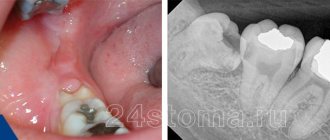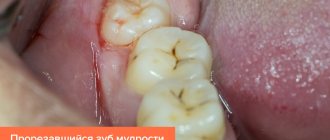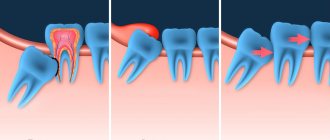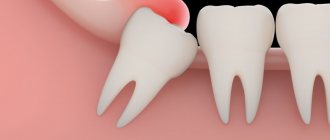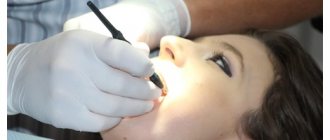For most people, the growth of wisdom teeth is accompanied not only by gum cutting and discomfort, but also by quite severe pain that makes it difficult to eat, concentrate on any task, and even sleep.
If the wisdom tooth grows and does not cause significant discomfort, no medical action may be taken. As a rule, the discomfort goes away after 1-2 weeks, but in order to avoid the manifestation of other problems, it is worth undergoing an examination at a dental clinic. However, if the gums from the wisdom tooth become inflamed, the local and general temperature rises, and specific aching pain is felt, immediately contact your dentist, he will conduct an examination and take the necessary measures to eliminate the problem.
Signs of growth of the eight
The emergence of a wisdom tooth to the surface is usually accompanied by pain. The discomfort is due to the fact that the bone tissue damages the gums. In addition, in place of wisdom teeth, precursors are not formed, which facilitate the process of the appearance of permanent elements. The pain when figure eights appear can be compared to the discomfort that small children experience during the process of teething. In addition to pain, other signs of the condition are also noted - itching, swelling of the soft tissues of the gums. Not in all cases, the teething process is accompanied by discomfort. Sometimes people discover a new tooth in their row completely by accident.
Other symptoms of the condition:
- swollen gums located away from the problem element;
- radiating pain to the head, ear or cheek;
- difficulty swallowing;
- the appearance of bad breath.
The last sign appears due to the fact that during the process of eruption a hood is formed above the figure eight. It is a compaction of overgrown mucous membranes. Plaque, bacteria, and food particles accumulate under the hood, eventually leading to bad breath.
In severe cases, a person develops symptoms of malaise and intoxication. Also, severe eruption of the element is accompanied by fever, inflammation of the submandibular lymph nodes, and severe headaches. Signs of the condition are individual for each person. There may be only one or many signs of a problem. The duration and intensity of the symptoms of figure eight eruption are also individual in each specific case.
Wisdom tooth hood
How long does a tooth hurt when there is a complication?
If the wisdom tooth does not grow in the required 60 days, something did not go according to plan. And in such cases, when talking about timing, dentists do not undertake to give any forecasts. Perhaps, with careful adherence to oral hygiene and constant monitoring by a doctor, the third molar will still grow in the near future.
But there is no less chance that the process will become chronic. Millions of people around the world experience excruciating exacerbations for years. The pain subsides for a while, but after a couple of months, and sometimes a couple of years, the tooth begins to cut again, and the pain returns with renewed vigor.
Complications associated with teething
With pathological germination of the figure eight, a number of complications can develop. A common disorder is pericoronitis. The disease is associated with inflammation of the tissues of the jaw and mucous membranes of the mouth.
Characteristic signs of pericoronitis:
- the appearance of severe swelling and redness in the eruption area;
- sore throat when swallowing;
- deterioration of health;
- weakness;
- temperature increase;
- discharge of purulent masses when pressing on the gums.
Often pericoronitis becomes chronic, which is accompanied by pain and discomfort when pressing on the problem area. An abscess may form in place of the tooth.
Carious lesion is another consequence of improper eruption of figure eights. The fact is that the last molars may fit too tightly to the sevens, which makes it difficult to naturally clean the dental space from plaque and bacteria. As a result, caries develops with all its characteristic symptoms:
- darkening of the enamel;
- pain when chewing;
- tooth sensitivity.
Sometimes it happens that the figure eight comes out on the surface of the already affected gum.
Periodontitis appears after the eruption of the last molar. The pathology is characterized by inflammation of the gums due to the inconvenient location of the wisdom tooth in the gum. In this case, plaque and bacteria from the oral cavity are almost impossible to remove using standard hygiene measures. Bacteria in the space between the gum and tooth provoke inflammation and swelling of the soft tissues of the mouth. If a visit to the dentist is untimely, periodontitis is complicated by gumboil or periostitis.
What to do if a wisdom tooth comes out and your gums hurt
Symptoms of flux manifest clearly and are accompanied by:
- temperature rise to 40 degrees;
- swollen cheeks;
- swelling spreading to most of the face;
- intoxication of the body;
- excruciating pain.
As a result of abnormal eruption of the figure eight, a cyst can grow - a benign tumor filled with clear liquid. It contains particles of dead cells, bacteria and food debris. You can notice a cyst by protruding gums and discomfort when chewing food. Rarely, a cyst is accompanied by severe pain.
The appearance of a wisdom tooth above or below can cause damage to the trigeminal nerve. If it is violated, there is involuntary twitching of the face and severe sharp pain. In severe cases, facial paralysis may occur.
Abscess is one of the most severe complications associated with the pathological eruption of the last elements. It develops in the most patient patients. Among the signs of the disease are:
- sharp putrid odor from the mouth;
- constant feeling of bitterness;
- heat;
- throbbing pain.
When the abscess goes inside, phlegmon or an extensive inflammatory process develops. Swelling spreads to the entire face.
Cellulitis is a complication that can cause the patient’s death
You need to be attentive to all the symptoms that manifest the eruption of wisdom teeth. If pain persists for more than 2-3 days, then you need to seek help from a dentist. It is recommended to independently relieve the symptoms of the condition only if it is not possible to visit a specialist. For this purpose, it is permissible to use painkillers and traditional medicine. During a visit to the doctor, it is necessary to tell you that pain relief measures were taken regarding the problem unit.
When are third molars removed?
There are a number of reasons why removing “eights” is necessary:
- incorrect direction of the tooth during growth;
- lack of space;
- change in the position of the teeth (crowding);
- strong pressure on the seventh molar;
- process of purulent inflammation;
- crown destroyed by caries.
In some cases, your doctor may advise you not to pull out your molars.
For example, if a patient undergoes dental prosthetics, during eruption they will take the correct position, and the canals are clearly visible for further treatment.
When do wisdom teeth grow?
At what age do eights begin to grow? Each person has an individual time frame for the eruption of the last units. For some, eights appear on the surface of the gums as early as sixteen. However, such situations are rare. On average, this period occurs between the ages of 17–25 years.
The number eight can grow and form over a long period of time. For example, the tip of the tooth appears at the age of 20, and the final tooth is formed only at the age of 30–35. In some patients, the figure eights remain retracted, that is, they do not appear on the surface of the gums.
At what age do the last molars stop growing? These elements creep in throughout a person’s life. There have been cases where molars grew in older people.
Cutting through the figure eight is a long and complex process that takes from several months to several years. During this process, characteristic symptoms may worsen and subside.
Molar growth process
With proper growth, figure eight teeth do not cause any particular trouble to the patient. The physiological process ends with the vertical position of the extreme molar, which eliminates changes in bite, caries and the formation of a hood.
The patient may complain only of slight redness and thickening of the gums, mild pain, which can last from several days to a month.
During the eruption of extreme molars, some pathological phenomena may occur.
Most often, these include tooth deviations from vertical growth:
- The process of tilting the molar forward towards the seven is called medial tilt.
The process of tilting the molar forward towards the seven is called medial tilt. It can provoke the onset of caries in a neighboring tooth, the reason for this is constant pressure on the enamel and the accumulation of microorganisms in the gap formed between them.
- With a distal tilt , when the figure eight grows backward, its urgent removal is necessary.
- The eruption of a molar towards the cheek is accompanied by damage to its mucous membrane. The buccal tilt of the tooth can provoke malignant tumors at the site of damage.
- During horizontal and linguistic growth, compression of the roots of sevens , sixes and fives occurs. This causes an inflammatory process that requires immediate removal.
How long do eights grow?
The period for the last element to appear on the surface ranges from 4 weeks to 10 years. On average, patients may experience discomfort from the eruption of wisdom teeth for up to 1.5 months. After the crown appears, the discomfort subsides. Then there is a pre-formation stage, which can take up to 5–7 years. An element is considered formed after its roots appear, which can number from 3 to 5.
Only a doctor can decide whether to remove the problematic element or not. The main indications for surgical intervention are chronic pericoronitis, compression of the roots of an adjacent tooth by the figure eight, damage to the soft tissue of the gums on the crown of a molar. If there are no problems when cutting through the unit, then experts leave the eights untouched. These teeth are as important as all other elements, despite the fact that they do not take part in the digestion of food.
Squeezing an adjacent element with a figure eight
The last molars prevent the remaining teeth from moving to the side and prevent various malocclusions. When prosthetizing sevens, the last molars can be considered as a support for orthodontic structures. For this reason, doctors try to preserve the element even if it is damaged by caries.
Function of the eighth molars
Dentists call them spares. Where does the wisdom tooth grow? It stands on par with the others, is classified as molars, but is practically not used for chewing food. The main purpose is to hold teeth so that they do not become loose and move apart. If a nearby molar is lost, it will take its place and perform the necessary functions. During dental prosthetics, the figure eight can become a support. During development, the human skull has changed, the jaw has become smaller and there is no room for a molar. Young people do not have such a tooth even in its rudiments.
What determines the symptoms of teething?
At what age does a figure eight form? Typically, the coronal part of the element is formed by the age of 14, when the dentofacial system is fully formed. Teeth are cut much later – between the ages of 18 and 30.
The faster the tooth appears on the surface, the lower the risk of complications. The rate of tooth growth depends on the availability of free space in the oral cavity and the density of the gum tissue. Such conditions are rare, and patients usually have to contact their dentists when the last elements appear on the surface. With prolonged growth, a hood is formed near the gums, under which food debris gradually gets stuffed. This environment is optimal for the development of pathogenic flora.
The dentist helps get rid of the unpleasant symptoms of teething by opening the hood and washing it with antiseptic solutions. Sometimes the surgeon makes an incision in the gum to facilitate the process of tooth emergence. If there are clinical indications, the molar is removed without waiting for it to come out.
Where can I get dental care in Orenburg?
If your gums hurt where your wisdom teeth are, you can get qualified dental care in two places: public and private dental clinics. During the appointment, the dentist must:
- Conduct a preliminary examination of the oral cavity, determine the exact cause of the development of painful symptoms;
- If necessary, refer the patient for an x-ray - this procedure is often necessary in the presence of impacted wisdom teeth (completely or partially covered by gum), as well as in the case of surgical removal;
- Take the necessary measures to reduce or eliminate pain and swelling, as well as prevent further aggravation of the situation;
- If necessary, refer to a dental surgeon to remove third molars;
- Provide recommendations for further dental and oral care.
Do your gums hurt and you have symptoms of wisdom tooth growth? Seek qualified help from specialized specialists!
General recommendations for teething
What to do when third molars appear? At the first symptoms of a problem, you should consult a doctor. If this is not possible in the next few days, then at home you can also make it easier for the tooth to come out. First of all, you need to clean your mouth with a paste and brush to deactivate the pathogenic flora. After hygiene measures, the mouth is rinsed with antiseptic solutions or herbal decoctions that have an anti-inflammatory effect (calendula, chamomile, oak bark). You can use just one herbal ingredient or several herbs to relieve pain.
It is forbidden to pierce the gums with sharp objects on your own. Such actions can lead to even greater swelling of the soft tissues and the spread of infection throughout the body. It is also not recommended to constantly touch the problem area with your hands and tongue. During the visit, the dentist will ask the patient to undergo an X-ray examination to determine the integrity of the wisdom tooth and the location of its roots. If an element is affected by caries or its roots are pressing on adjacent teeth or more elements, then extraction is suggested. After tooth extraction, patients must adhere to all the specialist’s recommendations so as not to provoke complications.
How to accelerate growth?
It is impossible to speed up the process of teething: it depends on the characteristics of the whole organism and the structure of the jaw, the location and direction of the “eights”. In this case, only the symptoms can be eliminated.
But it is important to remember: heating the gum or cheek is strictly prohibited!
This provokes an acceleration of the inflammation process and the rapid spread of infection to the nearest teeth.
It is also not recommended to rinse the mouth with hot decoctions. It is best to use a decoction of salt and soda before going to the dentist: it has disinfecting properties, will remove food particles and reduce pain.
Under no circumstances should you cut the gum tissue yourself using sharp objects. This can lead to severe bleeding and infection.
Step-by-step process for wisdom tooth removal
At what age do third molars appear?
There are no “eights” in the milk bite. Moreover, their rudiments are not laid during the intrauterine development of the fetus; this process begins only closer to 4-5 years. Crowns are finally formed by 11-12 years, and roots only by 24-26 years. It is believed that around this period they begin to break out. But in practice, situations are common when they appear much later, for example, after 30 years. Or they don’t make their way out at all until the end of life, or they appear only partially (not in full).
When pain is normal
When a tooth is cutting and your gums hurt, this condition can be considered normal. The sensations should not be too sharp; they are rather nagging and dull, monotonous, aching.
Do not forget that the tooth began to emerge in adulthood; it did not have a milk predecessor that would have left behind a “beaten path.” The bone tissue of an adult has finally formed, the gums are dense and thick, and it is natural that the third molar injures and damages tissue and touches nerve endings when it passes through them.
Features of growth and development
At what age do the last molars appear on the surface? The rudiments of elements are formed in children at the age of 3. Therefore, any disturbances in the prenatal period, malnutrition or childhood traumas are reflected in the structure of the eights and affect the time of eruption. It takes much longer for the last molar to fully form.
There are several stages of growth for eights: at 17-22 years old; at 25-35 years old; at 30-40 years old. Elements may not appear on the surface at all. Incomplete wisdom teeth (1, 2 or 3 erupted units) are common.
The number of eights that come out depends on several factors:
- heredity;
- presence of chronic diseases;
- the number of formed primordia;
- jaw shapes and sizes.
The process of tooth growth begins at 3 years of age and ends by 14-16 years of age. The process of formation of the last elements can take 25 years or more. The speed of teething depends on the anatomical features of the patient’s jaw structure and the influence of external factors (ecology, food consumed, bad habits).
First, the crown of the wisdom tooth is formed, and only then the root and process.
The primary symptoms of the condition are itching in the gum area, swelling of soft tissues. After a certain time, the tip of the crown appears on the surface of the gum. The full eight will only come out in a few years.
During a period of intensive growth, a person may feel discomfort in the oral cavity. When teething slows down, the discomfort disappears. If we compare the process of teething in children and adults, we can note a significant difference. In babies, both the crown and the outgrowth of the mammary unit are immediately formed. For the last painters, only the crown is formed. The root development process may take another 3-4 years.
Dangerous symptoms
It is impossible to visually determine whether the last molar is positioned normally or crookedly. The final diagnosis is made only by x-ray. Crooked roots may require complex tooth extraction or sawing into pieces.
Untimely removal threatens the resorption of the roots of the wisdom itch and neighboring units, as well as the displacement of the seven to the wrong anatomical position.
A serious consequence of pathological growth of a wisdom tooth is an odontogenic cyst. The neoplasm also leads to disruption of facial symmetry
The reasons for the abnormal growth of the latest painters include:
- chronic bone diseases;
- hormonal imbalance in the body;
- metabolic disorder;
- oncology;
- incorrect location of the tooth germ.
It is worth noting the symptoms of wisdom tooth eruption, which require an immediate visit to the doctor. A dangerous complication is inflammation of the mucous hood or pericoronitis. When the disease occurs, acute pain is felt, radiating to the ear and temples. It becomes difficult for a person to eat and communicate (due to bad breath). When you press on the inflamed mucous membranes, you may notice purulent discharge.
Pericoronitis can only be treated with surgery. It is impossible to cope with the problem at home, even if you promptly and thoroughly treat the oral cavity with antiseptics. The surgeon opens the soft tissue with a scalpel and treats the wound with an antiseptic. Pericoronitis can recur regularly if a person does not have enough space for the wisdom teeth to fully erupt. In such cases, the doctor recommends removing the eights.
Emergency measures to eliminate signs of pericoronitis include treating the affected area with Miramistin and Chlorhexidine. Tempalgin, Ketanov and other NSAIDs are used to relieve pain.
If third molars appear on the surface affected by caries, then periodontitis may develop. Pathogenic flora from the enamel spreads to the roots of the tooth and soft tissues, causing a dental problem. Periodontitis occurs due to the presence of large amounts of hard and soft deposits on the surface of the units. Still others may have up to 5 roots, which complicates the process of treating them. In case of curved canals and the presence of many roots, the doctor prescribes removal of the problematic element.
A serious consequence of the problem under consideration is a dental cyst. The formation is a round cavity filled with liquid. You can understand that a cyst has formed by an increase in body temperature, swelling of the facial tissues on one side, and enlargement of the lymph nodes. At the initial stages of development, a benign formation does not manifest itself in any way. A cyst on the root of a tooth is treated with medication or surgery.
In advanced cases, other serious pathologies may develop:
- Flux is a purulent inflammation of the periosteum.
- Cellulitis is an extensive inflammatory process of the soft tissues of the oral cavity and bone structures of the jaw.
- Osteomyelitis is a purulent inflammation of the jaw bones.
To avoid the conditions described above, you should consult a doctor at the first symptoms of wisdom tooth growth.
What to do if the third molar is cut during pregnancy
If a wisdom tooth is cut incorrectly or irregularly during pregnancy, then the first thing a woman needs to do is see a dentist. This process requires close monitoring. The expectant mother cannot undergo surgical manipulations, so the main task is to prevent acute inflammation, which will make it necessary to take drastic measures - to remove the third molar.
To relieve symptoms, a woman can be prescribed antiseptics (for example, Miramistin), rinsing with herbal decoctions, as well as painkillers that are acceptable for the trimester of pregnancy in which she is.
Read about when dental intervention is permissible during pregnancy in the article on the website.
If there is an emergency need to remove a tooth, the doctor must assess all possible risks and conduct a thorough assessment of the health of the expectant mother and child.
Causes of discomfort
People of any age meet with this pathology. However, in practice, early wisdom tooth eruption (before 18 years of age) is rarely accompanied by pain. In adolescence, bone tissue is more pliable to external influences, so it is easier for the last molars to take the correct anatomical position. To eliminate signs of discomfort, it is enough to make an incision in the gums at the site where the future element appears. The procedure is performed under local anesthesia.
Wisdom teeth currently play no role. They practically do not participate in the process of chewing food and do not affect diction. However, the release of these units outside complicates a person's life.
Causes of discomfort:
- The tooth is located under the gum at an acute angle and puts pressure on the root of the seven. In dental practice, parallel presentation is also encountered, in which the crown injures the soft tissues of the cheek.
- The crown of the figure eight is too large compared to the rest of the row. In this case, there is simply not enough space for it to break through to the surface. The problem is more common in people with smaller body sizes.
- The appearance of caries in the enamel of the third molar. The problem manifests itself especially clearly if the crown breaks out for a long time. At this time, pathogenic bacteria have time to spread to the pulp and periodontal tissue. Signs of gum swelling appear as a result of impaired blood supply to the problem area.
After 30 years, gum tissue becomes denser and less elastic, so the eruption of the last teeth becomes more difficult.
Where did teeth get their name?
One of the theories, so to speak, “folk”, is associated with late periods of eruption. Allegedly, after 20 years of life, a person has already gained some experience and become wiser.
The scientific or “Darwinian” theory says that this happened during evolution. Human ancestors, monkeys, used their teeth not only for chewing and grinding food, but also for turning improvised devices and tools and participating in fights, so they lost them in their youth. And the third molars appeared late precisely so that the monkeys, already in old age, could at least somehow process food.

